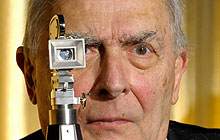|
|
|
|
Ruptures: Five Propositions on |
 |
|
One. The Nouvelle Vague can be cleanly divided up between the Moderns (Godard,
Rivette) and the Classicists (Rohmer, Truffaut) – with occasional defections
from one camp to the other, and back. But Chabrol, from first to last, remained
true to a particular Classical Narrative tradition: let’s call it the Element
of Crime.
Crime, in all its forms, obsessed Chabrol. He adapted
many key crime writers translated the world over, from Simenon and Ruth Rendell
to Ed McBain and Ellery Queen. And, of course, with his many collaborators, he
invented his own crime stories. As early as 1963, the British critic Raymond
Durgnat (in his farsighted monograph Nouvelle
Vague: The First Decade) linked Chabrol’s classical
strain with the ambition of a Balzac: to find the same themes, the same
characters even, in every sector and level and place in the social panorama.
Unlike Godard and Truffaut, but like Rohmer and
Rivette, Chabrol (after the attention garnered by his first two films) really
only came to be appreciated in the late ‘60s, when his craft clicked – but his
scepticism about radical politics (brutally expressed in his terrorist movie, Nada, 1974, which so angered
Fassbinder) put him at odds with cultural fashion. Chabrol seemed to cheerfully
accept that, for the rest of his life, he would always be (as The Beatles sang
of Sgt. Pepper) ‘going in and out of style’. He could be uneven, but so were
his tumultuous times. Like Rohmer, Chabrol chose his turf and furrowed it,
deeply, for five decades.
Two. Crime is linked to morality in Chabrol’s cinema. Not the morality of Rohmer’s
Moral Tales, where morality refers to the comedy (rarely the tragedy) of
manners, the ‘games of love and chance’ (Marivaux-style), a web of social behaviour. For Chabrol, morality is a matter of Evil. And Evil
expresses itself – potentially in every single character – by way of an act of
murderous violence.
The ground for this evil act is long prepared for by
the film, and its tricky consequences are painfully, painstakingly tracked
(think of La femme infidèle, 1969).
But crime always marks a terrible rupture of the social fabric, which
completely falls apart for a little while, before being nervously but
implacably stitched back together again – the sign of Chabrol’s deep, cruel and
constant irony (fanned, for years, by the underrated scriptwriter Paul
Gégauff).
Social transgression is both desired and feared by
Chabrol’s characters, his ‘ants in a glass case’ as Fassbinder called them. And
Chabrol enjoyed the perpetual destruction of his beloved bourgeois milieu with
delicious ambivalence – as both Endgame Anarchist and Sad Epicure – an
ambivalence expressed at its most paroxysmic, intense point in La Cérémonie (1995).
Three. As early as 1959, Chabrol defined his way of working, his dramaturgical
structure: each character’s personality would be embodied in a physical, visual
way of being that is clearly underlined from their entry into the film; in the
course of the story, however, this appearance (for it is always a masque, a pose) would then be slowly
stripped away, and the true, inner self revealed.
This peeling-away process is mapped onto Chabrol’s
beloved two-character criss-cross geometric template: two starkly different people,
from different levels of society, will enter into a gradual exchange, a
transformation, a transference, often with buried
erotic (regularly gay) overtones. And so the inner self is never stable, always
malleable in an intersubjective dynamic; and thus no one is ever purely Good or Evil. Morality and crime happen on a perpetually
sliding scale in Chabrol’s cinema.
Four. The Nouvelle Vague is famous for going out into the streets, the bistros, the
galleries and the métros. Not so, usually, for Chabrol. He was a Chamber
Director, an artist of interiors. Godard admired, in Les cousins (1959), how his friend was able to “explore every
corner” of the central apartment-set, to constantly vary and reveal it, with
the help of his superb designers Jacques Saulnier (Resnais’ right-hand man) and
Bernard Evein (Demy’s ace in the hole). Chabrol is the great painter of dinner
scenes, party scenes – and vulgar, grotesque meals, too, as in his extreme
limit-case
In fashioning his aesthetic of the interior, Chabrol
evolved three key techniques. The first is part of the script structure: the
powerful reversals, where what we expect to happen is overturned by the exact
opposite outcome (the endings of Le boucher, 1970, and Les
cousins). The second relates to staging, to mise en scène: Deborah Thomas, in her study of ‘frame-breaking, embarrassment and
irony’ in Chabrol, outlines all the codes of bodily comportment, of gestures
allowed or broken, in these vast, soulless homes. The third
is an unostentatious moving-camera technique, nothing like the lyrical Ophuls
or even the careful reframings of Lang: Chabrol became (as Godard well noted)
the master of the panning shot, which connects and separates, which leads us to
quiet revelations …
Five. I was once handed a script by a film distributor looking to invest in future
productions: it was Au cœur du mensonge (1999) by Chabrol and Odile Barski. I read it, and was disappointed, even
disenchanted: what a banal mystery-thriller story! What tired, formulaic stuff!
I should have heeded Chabrol’s own, famous advice from
his Cahiers essay “Little Themes” in
1959: “The smaller a theme is, the more one can give
it a big treatment”. When I eventually saw the finished film (which I advised
the distributor to reject!), I was chastened: it was indeed in the style, the
treatment, that the script (every word of it respected) became taut,
suggestive, atmospheric – and profoundly meaningful. In the framings, the
camera movements, the gestures and postures, the music, the play of on– and
off-screen space.
Chabrol had said that a theme is “a decoy that which
from time to time becomes a booby-trap”. I fell,
momentarily into that trap. But Chabrol? Never.
MORE Chabrol: L'Enfer, Madame Bovary, Docteur M
© Adrian Martin September 2010 |
![]()